Innovative Bathroom Ideas for Modern Homes
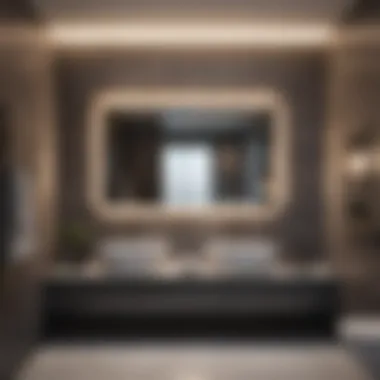
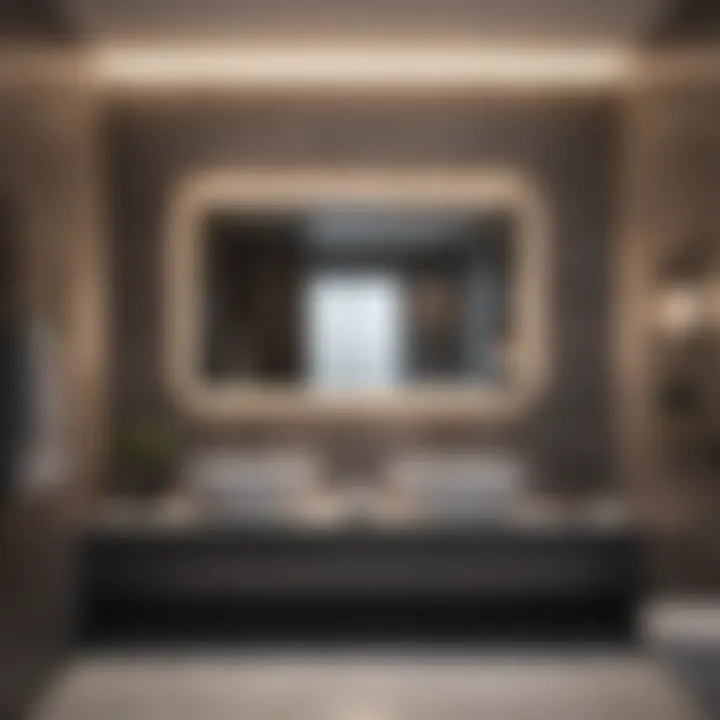
Intro
In today’s fast-paced world, the bathroom often serves as a personal haven. This space, typically overlooked, holds immense potential to reflect the homeowner’s style and promote relaxation. By embracing innovative bathroom ideas, it is possible to craft a more inviting and functional environment. This article aims to delve into the latest trends and practical solutions to enhance your bathroom experience.
Current Trends
Bathrooms have evolved significantly in recent years, showcasing various trends that cater to both aesthetics and functionality.
Color Palettes
The choice of colors can profoundly influence the ambiance of a bathroom. Light hues, such as soft whites and pastels, create an airy feel, while deeper shades, like navy and emerald, bring depth and richness. Earthy tones are also rising in popularity, offering warmth and synergy with natural elements. Homeowners are increasingly mixing colors strategically to achieve a sophisticated look.
Popular Styles
Modern design styles are reshaping our approach to bathroom aesthetics. Here are a few noteworthy styles:
- Minimalist: Emphasizes simplicity with clean lines and functional decor.
- Industrial: Incorporates raw materials like metal and reclaimed wood for an edgy look.
- Scandinavian: Promotes warmth with natural materials and bright, open spaces.
All these styles share a common theme: they prioritize practicality without sacrificing beauty.
Visual Ideas
A well-designed bathroom can significantly improve a home’s appeal. Here are some valuable visual ideas to consider:
Gallery of Styled Bathrooms
Investigating styled bathrooms can serve as inspiration for your own space. Consider different layouts, fixtures, and decor that resonate with your personal taste. Online resources, such as Pinterest and home design websites, can provide endless visual ideas to help guide your renovation plans.
Before-and-After Transformations
Before-and-after images illustrate the transformative power of thoughtful design. Small changes can lead to striking results, whether through reorganizing layouts or updating fixtures. These transformations often highlight the importance of planning and execution in achieving the desired outcome, showcasing how a tiny space can be reimagined as a serene retreat.
"An innovative bathroom transforms a mundane routine into a luxurious daily experience."
In summary, innovative bathroom ideas encompass a range of styles, colors, and practical solutions. By understanding current trends and gaining inspiration from visual resources, homeowners can create spaces that are both stylish and functional, making the bathroom an oasis within their homes.
Prelude to Bathroom Design
Bathroom design plays a critical role in shaping the overall aesthetic and functionality of a home. In any modern residence, the bathroom is not merely a space for hygiene but a vital oasis for relaxation. Maximizing the utility of this often-overlooked area calls for careful thought and innovative ideas.
When thinking about bathroom design, homeowners must consider several key elements. First, layout is foundational. The arrangement of fixtures such as sinks, toilets, and showers affects both usability and flow. A well-planned bathroom eases movement and allows for a more enjoyable experience.
Another vital aspect is the choice of materials. They can enhance the visual appeal while also providing durability and ease of maintenance. For instance, water-resistant materials are essential in preventing mold and damage. Careful consideration of color and texture can greatly influence moods and perceptions, making a traditionally utilitarian space feel more inviting.
The benefits of good bathroom design extend beyond visual aesthetics; they include increased property value. Modern, well-designed bathrooms appeal to prospective buyers. This makes strategic design decisions not just a matter of personal preference but also an investment in the home.
Moreover, the trend towards wellness has stirred interest in bathroom environments that support relaxation and personal care. Features like freestanding tubs, smart technologies, and eco-friendly fixtures are becoming more prevalent. These innovations cater to the desire for luxurious experiences in home settings.
Understanding Functional Spaces
Understanding functional spaces is crucial for designing an effective bathroom. A bathroom must not only be aesthetically pleasing but also serve its practical purpose efficiently. Each element, from fixtures to layout, influences both the functionality and the flow of the space. Homeowners should consider how they use their bathrooms on a daily basis and plan accordingly.
Analyzing Layouts
Evaluating different layout options is essential when redoing a bathroom. A well-thought-out layout can significantly enhance usability. Common layouts include the single-wall, L-shaped, U-shaped, and galley designs.
- Single-wall layout: This design maximizes space and is ideal for smaller bathrooms. All fixtures are lined against one wall, which allows for easy access.
- L-shaped layout: This layout offers flexibility, making it suitable for medium-sized bathrooms. Fixtures are placed along two adjacent walls.
- U-shaped layout: This provides ample space for storage and fixtures but requires a larger area. It promotes easy movement within the room.
- Galley layout: This is efficient for narrow bathrooms and ensures a smooth workflow.
Each option has its advantages and constraints. Evaluate the size and shape of your bathroom before making a choice, ensuring it aligns with your daily routine and enhances ease of use.
Maximizing Flow
Creating a smooth flow in the bathroom is about more than just the placement of fixtures. It's also about the distance between them and how users move through the space. Well-placed items reduce clutter and promote a feeling of openness.
- Accessibility: Ensure that all areas are easily reachable. This includes spacing between fixtures, making sure doors do not hinder movement, and utilizing corners effectively.
- Zoning: Consider establishing zones within the bathroom, such as a dressing area separate from the shower and toilet.
- Pathways: Ensure there are clear lines of movement. The pathways should be wide enough for comfortable access, especially in a multi-user environment.
- Furniture Arrangement: If using furniture, it should not obstruct pathways or access to essential fixtures.
Effective planning and layout can greatly enhance the experience of using your bathroom, transforming it from a mere utility room into a flow-efficient space that serves you well.
Minimalistic Bathroom Designs
Minimalistic bathroom designs have become a focal point for contemporary home aesthetics. This approach prioritizes functionality while offering visual tranquility. The essence lies in creating an environment that feels open and uncluttered. With the rise in importance of personal retreats within the home, a minimalist bathroom can provide that serene sanctuary. This section explores the key elements, benefits, and considerations surrounding minimalistic designs to help you navigate your renovation process.
The Power of Simplicity
Simplicity is the hallmark of minimalistic design. It invites users to embrace a philosophy that values quality over quantity. In the bathroom, this means selecting few, but meaningful items. Instead of overcrowding the space with excessive decor, fewer pieces are chosen that enhance the overall aesthetic. This can lead to a greater sense of calm and focus within the space.
For instance, a single, beautifully crafted sink can serve as both a functional and artistic focal point. Open shelving can also replace bulky cabinets, allowing selected decorative items and essential toiletries to shine without overwhelming the senses.
"Minimalism is not a lack of something. It's simply the perfect amount of something."
— Anonymous
Material Choices for Minimalism
Material selection plays a significant role in achieving a minimalist look. When choosing materials, homeowners should prioritize items that are both durable and aesthetically pleasing. Some popular options include:
- Ceramic Tiles: These tiles are versatile and come in a variety of colors and textures. They pair well with clean lines and complement other minimalist features.
- Natural Stone: Materials like marble or granite can add a luxurious touch while maintaining simplicity. Their unique patterns can draw attention without being overpowering.
- Glass: Utilizing glass for shower enclosures or partitions can contribute to an open feel while maximizing light flow.
- Wood Accents: Using natural wood can bring warmth to the minimalist design. This can be achieved through shelving or cabinetry that still reflects clean lines.
Innovative Storage Solutions
Efficient storage solutions are essential in creating organized and functional bathrooms. An innovative approach to storage not only enhances the aesthetics of the space but also maximizes its usability. Clutter can quickly turn a relaxing bathroom into a chaotic environment, making it necessary to find effective ways to store items while maintaining a clean look.
The benefits of innovative storage solutions are manifold. Firstly, they help in keeping frequently used items accessible, which streamlines daily routines. Secondly, they allow for creative optimization of otherwise wasted space, such as vertical areas above countertops or even behind doors. Lastly, strategic storage minimizes the time spent searching for items, contributing to a more serene atmosphere.
When considering storage solutions, it is essential to focus on the type of items that will be stored. Categorizing products by usage can be beneficial. For example, keeping toiletries within easy reach while more seasonal items go in less accessible locations can facilitate a smoother experience. Additionally, the aesthetic should match the bathroom's overall design scheme.
Vertical Storage Ideas
Vertical storage solutions are particularly effective in maximizing space in smaller bathrooms. When floor space is limited, utilizing height can often lead to improved organization and functionality. Shelves, wall-mounted cabinets, and over-the-toilet units all provide great opportunities for vertical storage.
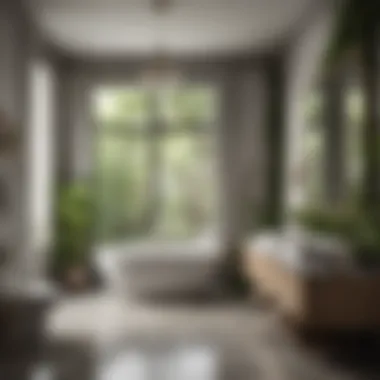
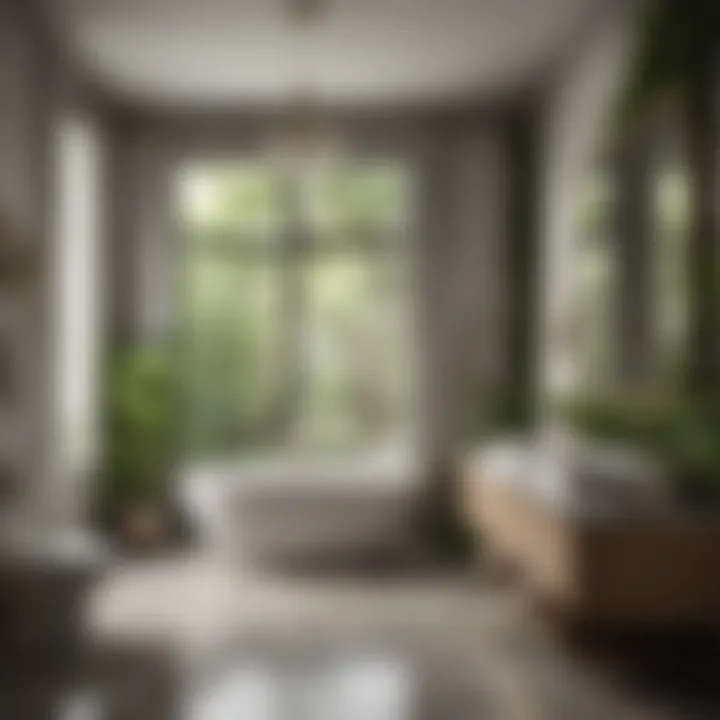
One practical option is to install shelving units that go from floor to ceiling. These can accommodate a variety of items, from towels to decorative containers holding bathroom necessities. A combination of open and closed shelving can add depth and allow for both display and concealment of items, making it visually appealing.
Benefits of Vertical Storage:
- Utilizes otherwise unused wall space.
- Keeps essential items visible and easy to grab.
- Reduces clutter between surfaces.
In addition, installing hooks or pegboards can offer flexibility in organizing various tools or accessories. This approach encourages users to categorize similar items together, further maintaining a tidy feel.
Under-Sink Organization
Under-sink areas present unique challenges for bathroons. This zone often becomes a dumping ground for cleaning supplies, toiletries, and equipment. However, innovative under-sink organization can transform this chaotic space into an efficiently managed storage area.
Using stackable bins or pull-out drawers helps in segregating items and improves accessibility. It's also worthwhile to invest in adjustable organizers that can expand and fit snugly into the space. Moreover, adding a tension rod to hold spray bottles vertically can free up horizontal space, allowing for more efficient use of the area.
Effective Tips for Under-Sink Organization:
- Utilize pull-out baskets for easy access.
- Install tiered racks to maximize height.
- Keep cleaning supplies in a dedicated compartment to prevent spills.
This organizational approach not only increases functionality but also helps maintain a cleaner look, contributing positively to the bathroom's overall ambiance.
Color and Texture in the Bathroom
Color and texture play a pivotal role in setting the mood and functionality of a bathroom. The right color scheme can evoke tranquility, energy, or even warmth, making the space feel inviting or refreshing. Texture, on the other hand, adds depth and can enhance visual interest while also influencing tactile experiences. Both elements work in tandem to create an environment that is not just practical but also pleasing to the eye, which is crucial for personal retreats like bathrooms. Incorporating smart color choices and diverse textures allows for a bathroom that reflects personal style and meets functional needs.
Color Psychology
Understanding color psychology is essential when designing a bathroom. Colors influence human emotions and behaviors. For example, blue hues are often associated with calmness and serenity, making them ideal for a bathroom where relaxation is key. Shades like soft greens or grays can also have soothing effects. On the flip side, brighter colors like yellows or oranges can stimulate energy and vitality but might not be suitable for a relaxation-focused space.
- Choosing the Right Colors:
- Mixing Colors:
- Lighting Influence:
- Soft blues and greens for a tranquil space
- Warm neutrals for a cozy and inviting feel
- Bold accents to add personality
- Balance between dominant and accent colors
- Create a cohesive look with complementary shades
- Natural light can change the appearance of colors
- Artificial lighting can soften or enhance certain hues
Textural Contrast
Textural contrast is another key component that enriches bathroom design. Mixing different materials can create a dynamic appearance and elevate the tactile experience. Consider the juxtaposition of smooth tiles against rough stone surfaces or sleek fixtures paired with rustic wood accents. This contrast not only enhances aesthetic appeal but also serves practical purposes, such as improving grip in wet areas.
Benefits of Textural Contrast:
- Visual Interest: A mixture of textures draws the eye around the space, preventing monotony.
- Functionality: Certain textures can solve practical issues, like safety in wet conditions.
- Layering: Adding rugs, towels, or decorative items can soften hard surfaces and create warmth.
Incorporating color and texture thoughtfully in the bathroom can lead to a space that feels both luxurious and inviting. This careful combination can make a significant difference in how the area is perceived and used.
Eco-Friendly Bathroom Ideas
In recent years, the demand for eco-friendly bathroom ideas has increased significantly. Homeowners are now more conscious of their environmental impact and seek ways to integrate sustainable practices into their homes. Implementing eco-friendly elements in the bathroom not only conserves resources but also creates a healthier indoor environment. This section delves into two significant aspects of eco-friendly bathrooms: sustainable materials and water-saving fixtures.
Sustainable Materials
Selecting sustainable materials is a fundamental aspect when designing an eco-friendly bathroom. Options such as bamboo, recycled glass, and stone are excellent choices. Bamboo, for instance, is a rapidly renewable material that requires less water and pesticides compared to traditional wood. It is strong and naturally resistant to moisture, making it ideal for bathroom applications.
Recycled glass is another fascinating option, often used for countertops and tiles. By choosing recycled glass, homeowners contribute to waste reduction while enjoying unique and aesthetically pleasing surfaces.
Considerations for Material Selection:
- Select local products to minimize transportation emissions.
- Look for certifications that indicate sustainable sourcing, such as FSC (Forest Stewardship Council) for wood.
- Overall durability of the material can reduce the need for replacements, further minimizing waste.
In summary, using sustainable materials makes a significant contribution to both environmental conservation and style. The aesthetics of a bathroom can merge beautifully with responsibility toward the planet.
Water-Saving Fixtures
Water-saving fixtures play a vital role in creating an eco-friendly bathroom. They help reduce water consumption without compromising performance. Features like low-flow showerheads, dual flush toilets, and faucets equipped with aerators can significantly cut down on water usage.
Examples of Efficient Fixtures:
- Low-Flow Showerheads: These fixtures can reduce water flow by 40%, giving a remarkable savings in both water and energy costs.
- Dual Flush Toilets: With a choice for liquid or solid waste disposal, these toilets can save up to 13,000 gallons of water each year per household.
- Faucet Aerators: Easily attachable to the end of faucets, these devices mix air with water, providing a steadier flow while using less water.
Incorporating these fixtures not only aids in reducing environmental impact but also lowers utility bills.
"Water conservation is crucial in every home, especially in the bathroom, where fixtures can influence daily habits significantly."
Ultimately, adopting water-saving fixtures transforms everyday routines into opportunities for sustainability. This practical approach is significant for any homeowner interested in eco-friendly renovations.
Luxurious Bathroom Features
Creating a bathroom that embodies luxury is not merely about aesthetics; it involves a thoughtful integration of elements that enhance both functionality and comfort. Luxurious bathroom features elevate the everyday experience of a home, transforming a functional space into a personal haven. By focusing on the right blend of technology, materials, and design, homeowners can craft an environment that aligns with their lifestyle and preferences.
Smart Technology Integration
In today's world, smart technology is becoming a staple of luxurious bathroom environments. Integrating smart devices can enhance comfort, improve efficiency, and bring remarkable convenience to daily routines. For example, smart showers allow users to customize water temperature, flow rate, and even lighting through their smartphones. These systems often incorporate voice controls, making it easy to adjust settings without manual interaction.
Additionally, smart mirrors equipped with touch displays enable access to weather forecasts, appointment schedules, and music playlists all while preparing for the day ahead. Installing smart lighting systems can adjust to various settings that enhance mood and ambiance. This kind of personalization in bathrooms meets the demand for both luxury and convenience.
Spa-Like Elements
To create an atmosphere of relaxation, spa-like elements are key features in luxurious bathroom designs. These elements go beyond mere decor; they influence the entire experience of unwinding. Incorporating a soaking tub, for instance, invites homeowners to indulge in long, soothing baths. Freestanding tubs can become a focal point, adding elegance while contributing to overall comfort.
Furthermore, high-quality fixtures, such as rainfall showerheads and body sprays, can mimic the experience of a luxurious spa. Adding materials like natural stone, soft textiles, and ambient lighting enhances this serene environment.
Key Features to Consider:
- High-End Fixtures: Choose taps and showerheads in stylish finishes like brushed nickel or matte black.
- Quality Materials: Use materials such as marble or quartz for countertops and walls.
- Textured Elements: Introduce plush towels and bath mats to add comfort.
- Aromatherapy: Incorporating scented candles or essential oil diffusers can enrich the sensory experience.
"A thoughtfully designed bathroom should provide a retreat from the outside world; luxurious features play a crucial role in creating that sanctuary."
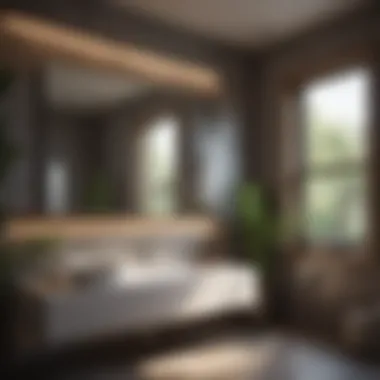
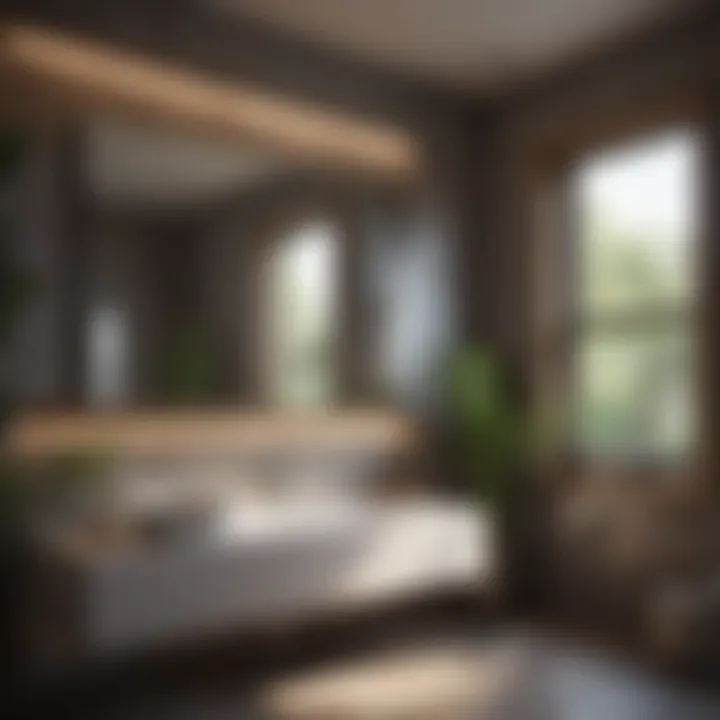
In summary, through the integration of smart technology and an emphasis on spa-like elements, homeowners can achieve a luxurious bathroom that combines convenience with relaxation. Balancing modern innovations with plush features ensures not only a visually appealing space but also one that enhances daily living.
Emphasis on Lighting
Lighting plays a crucial role in bathroom design. It influences both functionality and ambiance. Good lighting can enhance the beauty of your space, making it feel more inviting. It is also practical, helping you perform daily tasks like grooming and cleaning with ease. When designing bathrooms, consider the types of lighting and its placement to create a cohesive environment.
An effective lighting strategy balances bright illumination for tasks and softer, ambient lighting for relaxation. In addition, different fixtures can contribute to the overall aesthetic of the room. Addressing lighting with foresight can transform an ordinary bathroom into a stylish haven.
Types of Lighting
There are several types of lighting to consider when designing a bathroom. Each has its specific purpose and can drastically change the feel of the space.
- Ambient Lighting: This is the general, overall light in the room. It should provide sufficient illumination for daily activities. Common sources include ceiling-mounted fixtures or recessed lighting.
- Task Lighting: Placed near mirrors or specific work areas, task lights are necessary for precision activities like shaving or makeup application. Wall sconces or vanity lighting are suitable options.
- Accent Lighting: This type can highlight design features, mirrors, or artwork in the bathroom. It adds depth and interest, creating visual appeal.
- Natural Light: If possible, utilize windows or skylights to bring in daylight. Natural light improves mood and makes the space feel more expansive.
Mood Setting with Light
The ability to change the mood of your bathroom is significant. The right lighting can influence feelings of relaxation and rejuvenation.
Consider incorporating dimmers to easily adjust light levels. This way, you can have bright light for maintaining the space and dimmer light for creating a soothing atmosphere during a bath.
Using warmer light tones helps create a cozy environment. Where colder lights may seem harsh or clinical, warm lights provide comfort alongside clarity.
Additionally, colored lighting can enhance the ambiance. For example, soft blues and greens can promote calm, while warmer tones can evoke warmth. Small changes to light sources can lead to a great transformation in the feel of your bathroom space.
Proper lighting enhances both aesthetic appeal and functional usability. Design with intention to maximize the overall experience in your bathroom.
Incorporating Nature
Incorporating nature into bathroom design has gained significant traction in recent years. This trend reflects a broader movement towards creating spaces that promote well-being and tranquility. The bathroom, often a personal sanctuary, benefits greatly from the inclusion of natural elements. By integrating plants and maximizing natural light, homeowners can transform an otherwise utilitarian space into a calming retreat.
Benefits of Incorporating Nature:
- Improved Air Quality: Plants are known to filter pollutants from the air. In a bathroom, this can create a fresher atmosphere.
- Stress Reduction: Nature has a natural calming effect. Being surrounded by greenery can reduce anxiety and improve mood.
- Aesthetic Appeal: Natural elements enrich visual interest in the design. They can soften hard surfaces and add color.
When considering how to incorporate nature, homeowners should think about balance and sustainability. Careful selection of plants and the consideration of light sources are vital. The goal is to create a harmonious atmosphere that enhances the overall bathroom experience.
Plants in the Bathroom
Utilizing plants in the bathroom presents both aesthetic and practical advantages. Certain plants thrive in humid environments, making them ideal for this space. A few recommended options include:
- Peace Lily: Known for its air-purifying qualities and ability to thrive in low light.
- Spider Plant: Hardy and easy to care for, spider plants can adapt to bathroom conditions.
- Aloe Vera: Not only does this plant require little maintenance, but it also offers medicinal benefits.
When placing plants, consider:
- Shelves: Install floating shelves to display a variety of plants at different heights, creating visual interest.
- Hanging Planters: Ideal for smaller bathrooms, hanging planters free up countertop space.
- Window Sills: For those with adequate natural light, placing plants on window sills can help them flourish.
It is important to maintain these plants regularly, ensuring proper watering and sunlight exposure. Use biodegradable pots for a sustainable approach, thus further promoting eco-friendliness.
Natural Light Utilization
Natural light plays a critical role in enhancing the bathroom's ambiance. There are various ways to maximize this resource effectively.
- Windows: Installing larger windows brings in more light and creates a brighter, more open atmosphere. Frosted glass offers privacy while still allowing light to penetrate.
- Skylights: If structural possibilities allow, skylights can introduce abundant light, making the space feel airy and expansive.
- Mirrors: Strategically placing mirrors opposite windows reflects natural light throughout, enhancing the overall brightness of the room.
Natural light not only illuminates the space but also connects the interior to the outdoors, promoting a sense of serenity.
Consider opting for light-colored paints and materials in the bathroom to complement the natural light. Pale shades enhance luminosity and can create an illusion of more space. Additionally, these environments should be designed for flow; so every element, from window treatments to fixtures, should work together to maintain an aspect of openness.
In summary, incorporating nature in the bathroom leads to improved air quality, relaxation, and an appealing environment. Careful consideration of plant choices and natural lighting can make all the difference. Engaging with these elements will surely allow any bathroom to become a favored sanctuary in the home.
Versatile Flooring Options
Flooring is a critical aspect of any bathroom. It not only adds to the aesthetics but also affects functionality and maintenance. Choosing the right flooring material can enhance the overall look of the bathroom while providing safety and comfort. Considering factors such as durability, moisture resistance, and ease of cleaning is essential when selecting flooring for a bathroom.
Choosing Durable Materials
Durability is paramount when it comes to bathroom flooring. The bathroom often experiences high humidity and exposure to water. Therefore, selecting materials that can withstand these conditions is crucial.
- Ceramic Tile: This material is highly resistant to moisture and scratches, making it an ideal choice. It is available in various designs, including those that mimic wood or stone, providing versatility in style.
- Vinyl Flooring: Known for its water resistance, vinyl flooring is both affordable and easy to install. Modern vinyl comes in various styles and colors, allowing for creative freedom.
- Natural Stone: Materials like slate or granite offer a unique look and are durable. However, they require sealing to maintain their resistance to moisture.
- Laminate: Although less durable than ceramic or stone, laminate can still be a good choice if treated properly. It can provide the look of wood at a lower cost but needs to be installed with care to avoid water damage.
When selecting durable materials, consider the long-term implications of wear and tear. Researching each option's pros and cons can help homeowners make an informed decision.
Tile vs. Vinyl: A Comparison
When it comes down to flooring choices in a bathroom, tile and vinyl are often the main contenders. Each option offers its own unique benefits and drawbacks.
- Aesthetics: Tile often provides a more luxurious appearance and is available in various styles, sizes, and patterns. Vinyl, while increasingly stylish, may still be perceived as lesser in elegance.
- Durability: Tile is generally more durable than vinyl, particularly in terms of scratching and denting. Vinyl can be punctured or torn, especially if not of high quality.
- Water Resistance: Both materials are water-resistant; however, properly installed tile offers superior protection against moisture due to its hardness and the absence of seams. Vinyl, though water-resistant, can be compromised if seams become damaged or if water gets underneath the material.
- Cost: Vinyl is typically less expensive and easier to install. Tile may require professional installation, increasing the overall budget.
- Maintenance: Tile requires grouting maintenance, which can be an added chore. Vinyl is generally easier to clean but may discolor over time.
Deciding between tile and vinyl will come down to personal preference and bathroom usage. Each option can beautifully contribute to a bathroom’s design while fulfilling practical needs.
Creating a Relaxation Zone
Creating a relaxation zone in your bathroom is essential for transforming it into a sanctuary. This space serves as a retreat from everyday stress, allowing you to unwind and rejuvenate. To achieve this, careful consideration of both layout and aesthetics is necessary. The benefits include improved mental clarity, enhanced well-being, and a more inviting atmosphere for personal care routines. Thoughtful design choices can turn a simple bathroom into a haven for relaxation.
Defining the Space
Defining the relaxation area within your bathroom involves selecting an appropriate location and layout. Ideally, this spot should be easy to access yet somewhat secluded from the busy elements of the room. Many homeowners find that placing a cozy bath in a corner, near a window, or slightly separated by a partial wall works well.
- Consider using screens or curtains to create a sense of privacy.
- Ensure good lighting; natural light is preferable, but soft, adjustable artificial lighting can enhance the ambiance.
- Incorporate warm tones and textures in this space to make it feel inviting.
Incorporating Comfort Elements
Comfort elements can significantly enhance the relaxation zone experience. Focus on adding items that evoke a sense of calm and coziness. Some options might include:
- Soothing Textiles: Soft towels, bath mats, and plush robes can elevate comfort.
- Candles and Aromatherapy: These can create a serene environment. Scents like lavender or eucalyptus are particularly soothing.
- Sound Elements: Consider a small speaker for calming music or nature sounds.
The cohesion between these elements will make the space feel cohesive and inviting. Enhancing comfort needs thoughtful selection, so take your time to choose what resonates with you.
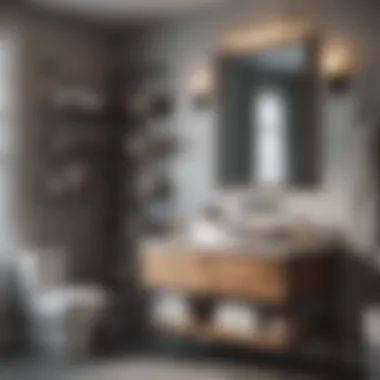
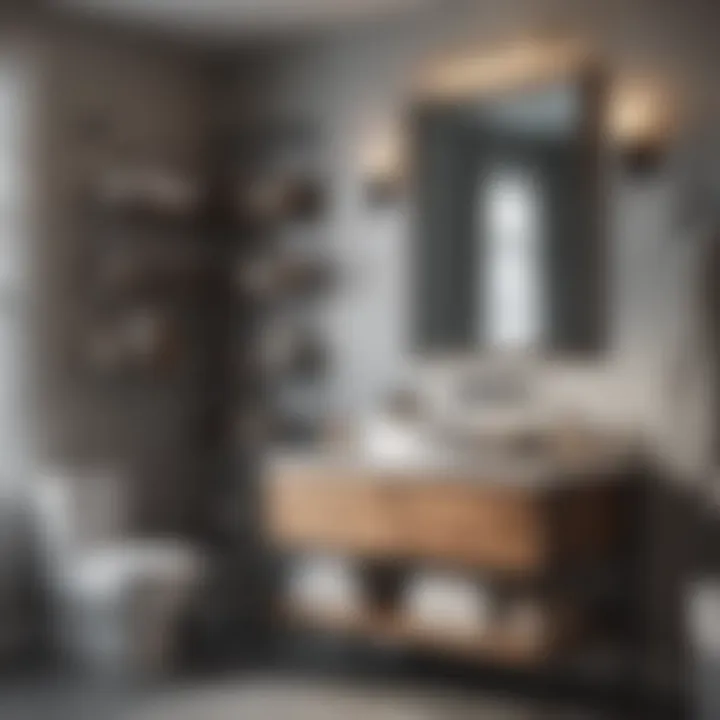
"A well-designed relaxation zone in your bathroom can transform self-care into an experience of mindfulness and tranquility."
In summary, creating a relaxation zone within your bathroom involves not just where things are placed, but also how they feel. Paying attention to the details and choosing elements that promote comfort will make a significant difference in how you experience your space.
Trendy Fixtures and Accessories
Trendy fixtures and accessories play a crucial role in modern bathroom design. They are not only functional but also serve as expressions of personal style. Incorporating the right fixtures can enhance the overall aesthetic of your bathroom while ensuring practicality and ease of use. Homeowners today are looking for ways to create environments that feel both chic and welcoming, making their choice of fixtures and accessories integral in achieving that goal.
In this section, we will explore different aspects of trendy fixtures and accessories, detailing how they can transform a simple bathroom into an elegant retreat.
Bathroom Fittings
Bathroom fittings are essential elements that can make or break the feel of the space. Choosing high-quality and stylish fittings elevates both functionality and design. Options such as contemporary faucets, unique sink designs, and showerheads with innovative features can significantly enhance your daily routines. When selecting fittings, consider the style you want to achieve. For example, a sleek, modern faucet adds a clean look, while vintage-style fittings can evoke a sense of warmth and nostalgia.
- Water Efficiency: Many modern bathroom fittings come with water-saving features that help reduce consumption without sacrificing performance. Look for fittings that are labeled as WaterSense approved, as these can contribute to eco-friendly goals.
- Materials: The choice of materials is likewise important. Options such as stainless steel or brass not only offer durability but also bring a contemporary edge to your design. Avoid plastic fittings, as they can detract from the overall quality of the bathroom.
- Finishes: Explore various finishes like matte black or brushed gold, which provide distinct visual appeal. These trendy finishes can act as focal points and can tie in with other design elements in the space.
By paying attention to these details, homeowners can select bathroom fittings that perfectly reflect their personal taste while being highly functional.
Decorative Accessories
Decorative accessories are the finishing touches that add personality to your bathroom. These elements range from towels and rugs to artwork and storage containers. The right accessories can transform a sterile environment into a cozy sanctuary, making them a vital consideration in bathroom design.
- Color Coordination: Use decorative accessories to introduce color and texture into the bathroom. For instance, vibrant towels or tasteful decor pieces can brighten up a neutral space.
- Functional Decor: Consider accessories that serve a dual purpose. Elegant storage solutions not only keep your bathroom organized but also contribute to the overall design. Look for attractive baskets or stylish shelving to enhance the decor.
- Artwork and Personal Touches: Incorporate unique artwork or personal items to make the space feel like your own. Whether it’s a framed mirror or a small sculpture, these pieces can add charm and character.
"The right decorative accessories breathe life into a bathroom, creating a welcoming atmosphere that reflects the homeowner's personality."
Maintaining Hygiene and Ease of Cleaning
Maintaining hygiene and ease of cleaning in the bathroom is essential for promoting a healthy environment. Bathrooms are high-traffic areas that can accumulate bacteria, mold, and mildew. Keeping this space clean not only enhances the aesthetic appeal but also contributes to the well-being of the household. A clean bathroom minimizes the risk of infections and unwanted odors. Furthermore, easy-to-clean surfaces and materials save time, making routine maintenance less daunting. This section will explore practical strategies to achieve a spotless and hygienic bathroom.
Choosing Easy-Care Materials
Selecting easy-care materials is a crucial step when it comes to maintaining hygiene. When designing a bathroom, prioritize materials that resist staining and are simple to clean. For walls and floors, materials such as porcelain and ceramic tiles are excellent choices. They are durable and resistant to moisture. For instance, using a high-gloss finish can help repel dirt and grime, making wipes and cleansers more effective.
Consider non-porous countertops, like quartz or solid surface materials. These offer seamless designs with no crevices for dirt collection. In addition to being aesthetically pleasing, they are resistant to bacteria. Furthermore, fixtures made from stainless steel or brass are also more hygienic than other materials. They are resistant to corrosion and are easier to manage long-term.
Benefits of Easy-Care Materials:
- Reduced Cleaning Time: Materials that require less frequent and extensive cleaning save both time and effort.
- Improved Durability: Easy-care products are typically more resistant to wear, extending the life of your bathroom fixtures.
- Enhanced Sanitation: Non-porous materials minimize microbial growth, keeping the space healthier.
Organizational Tools
The use of organizational tools facilitates a clean and tidy bathroom environment. Proper organization helps to declutter space, which is crucial for maintaining both hygiene and ease of cleaning. Invest in storage options that are both functional and easy to clean.
Consider using baskets, drawer dividers, and shelving. These tools can help designate spaces for different items, preventing the accumulation of unnecessary products. Wall-mounted shelves can be particularly effective. They utilize vertical space and keep items off countertops, making cleaning surfaces easier.
Look into modular storage systems which can be adjusted according to evolving needs. The adaptability is a major advantage, as it allows homeowners to rearrange items according to usage. Additionally, choose organizers made from easy-to-clean materials, such as acrylic or metal, to maintain not only aesthetic appeal but also hygiene.
"A well-organized bathroom is not just visually pleasing; it plays a vital role in hygiene and efficiency."
Recommended Organizational Tools:
- Clear Bins: Visibility ensures easy access to items, making cleaning quicker.
- Over-the-Door Organizers: These save space and keep items accessible while remaining hygienic.
- Magnetic Strips: Best for storing small metal items like scissors and tweezers, keeping them off the counter.
Personalizing Your Space
Personalizing a bathroom is often a reflection of individual style and preferences. This space can often seem cold or impersonal, depending on how it is decorated. By thoughtfully incorporating elements that resonate with the homeowner, one can enhance its charm and make it feel cozy and welcoming. Personalization goes beyond just aesthetics; it can create a sense of comfort and a unique sanctuary for relaxation and self-care.
In this context, there are several key components to consider when personalizing your space. First, think about functional personalization. This involves selecting items that cater not just to style but to your practical needs. For instance, certain storage solutions can be tailored for easy access to everyday essentials. Incorporating personalized items like family photos or cherished souvenirs can evoke memories and make the space feel more inviting.
"A well-personalized space transforms a bathroom from a mere utility into a comforting retreat."
Incorporating Personal Items
When discussing personal items in the bathroom, it is crucial to select pieces that hold meaning. It could be a handmade bowl or a vintage clock that has been passed down through generations. Displaying personal mementos creates character and warmth in your bathroom.
Here are some ideas to consider when incorporating personal items:
- Photo Frames: Add small frames on the countertop or shelves with pictures of family and friends. It adds a personal touch and brings joy when you see familiar faces.
- Travel Souvenirs: If you have traveled, consider showcasing small artifacts from your visits. This can be done through decorative trays or shadow boxes.
- Meaningful Quotes: Hang small signs or frames with quotes that inspire or uplift you. This encourages positivity every time you step into the space.
Unique Artwork and Decor
Unique artwork can transform the ambience of any bathroom. It can make the area feel less sterile and much more like a continuation of your home. Consider using pieces that resonate with your personality, style, or interest.
Here are some elements to think about while adding unique artwork:
- Wall Art: Large canvases or prints can become a focal point. Choose designs that reflect your tastes, whether it be serene landscapes, abstract designs, or even vibrant florals.
- Functional Art: Look for items that serve a purpose but are visually interesting. For example, a beautifully designed mirror or unique shelving can be both practical and aesthetically pleasing.
- Custom Decor: Invest in custom pieces, such as handmade ceramics for toiletries, or bespoke art made by local artists. This not only supports the community but also offers a one-of-a-kind touch to your bathroom.
In essence, personalizing your bathroom space combines functionality with flair. It allows each homeowner to express their unique identity and create an atmosphere conducive to relaxation and rejuvenation.
Culmination: Transforming Your Bathroom
In closing, the process of transforming a bathroom is not merely about aesthetics. It encompasses a wider range of considerations focused on functionality, comfort, and personal expression. A well-designed bathroom serves as a peaceful retreat, an essential space in the home that can greatly improve daily routines. By applying the ideas discussed throughout this article, homeowners can effectively enhance their bathrooms.
Importance of Thoughtful Design
The importance of thoughtful design cannot be overstated. When planning a transformation, it is vital to consider how each element contributes to the overall functionality. For instance, effective storage ideas allow for a clean, clutter-free environment while maximizing space. Eco-friendly materials not only reduce environmental impact but also promote sustainability—a growing concern for many homeowners today.
Benefits of Personalization
Personalizing your bathroom establishes a unique identity. Incorporating personal items and unique artwork can elevate the space from merely functional to truly personal. Such choices resonate with inhabitants and their guests, reinforcing the notion that this space is a reflection of individual taste.
Considerations for Planning
Several elements are key to consider during the design process:
- Space Allocation: Deciding on the layout to ensure optimal flow within the room enhances daily functionality.
- Material Selection: Choosing robust yet stylish materials helps maintain a balance between elegance and practicality.
- Lighting Strategy: A well-thought-out lighting strategy can set the mood while improving visibility during daily tasks.
- Innovative Features: Embracing modern technology, like smart mirrors or automated faucets, can contribute to increased convenience and luxury.
"A bathroom can be more than a utilitarian space; it can be a sanctuary where functionality meets comfort."
Final Thoughts
The journey of transforming a bathroom is one rich with opportunity. Whether the goal is to create a serene escape or a family-friendly environment, the insights shared in this article provide numerous avenues to explore. Ultimately, a well-designed bathroom contributes to both the quality of life and the overall value of your home. Every decision made during the transformation process plays a significant role in achieving the desired outcome, merging utility with style.



